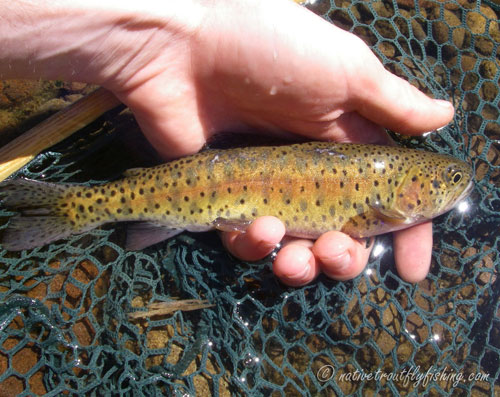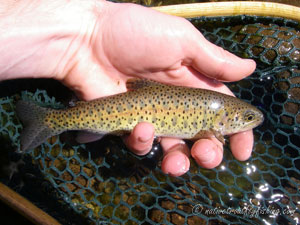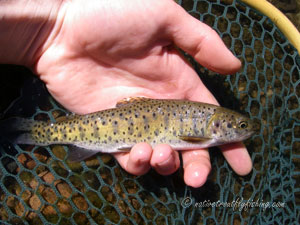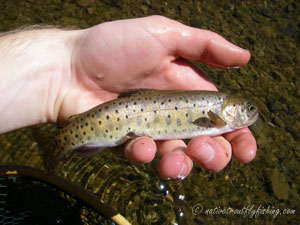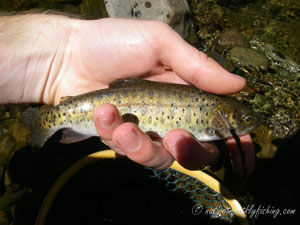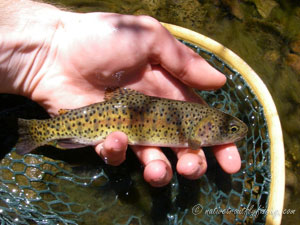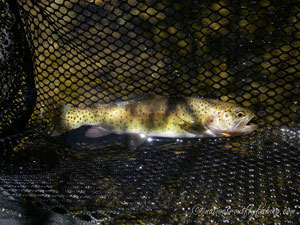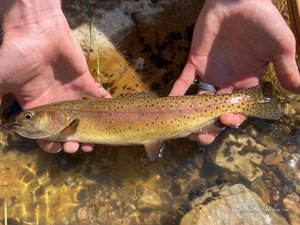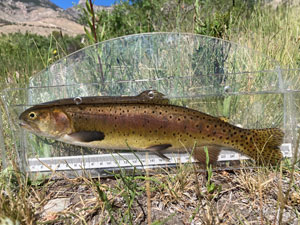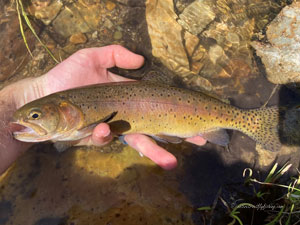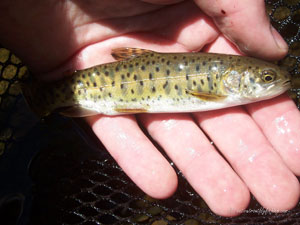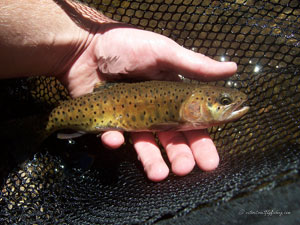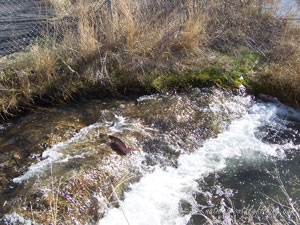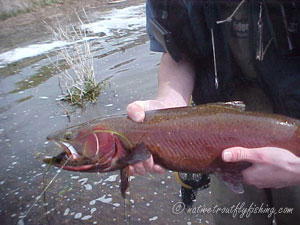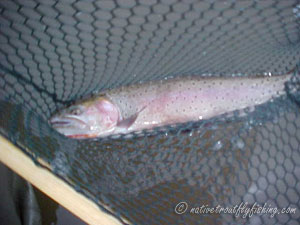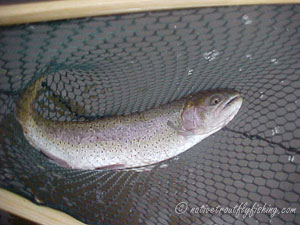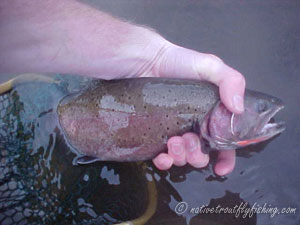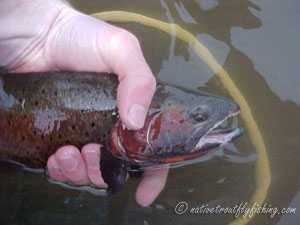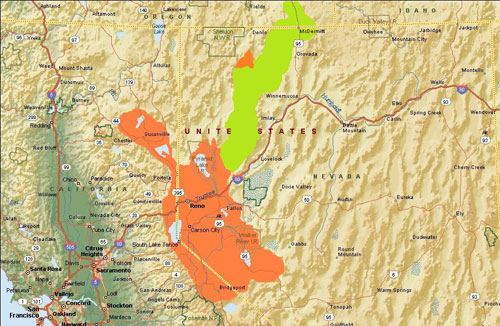Lahontan Cutthroat
Oncorhynchus henshawi henshawi
A Lahontan Cutthroat from the headwaters of a stream in Sierras of California.
Introduction
Lahontan Cutthroat is one of the four species of Cutthroat Trout and are native to the Lahontan Basin of Nevada and California (Trotter et al. 2018). In addition to Lahontan Cutthroat there five other subspecies associated with this species, the Humboldt Cutthroat, Quinn River Cutthroat, Paiute Cutthroat, Willow-Whitehorse Cutthroat and Alvord Cutthroat (presumed to be extinct). The Lahontan Cutthroat Trout are an ancient lineage of Cutthroat Trout, which are derived from the oldest known member of the Cutthroat lineage, Onchorhynchus belli, whose fossils were found in the Lahontan Basin and date back to 10 million years ago (Smith and Stearley 2018). The modern Lahontan Cutthroat Trout adapted to a lacustrine environment in ancient Lake Lahontan, which existed during the last ice age and was about the size of present-day Lake Erie. As the level of Lake Lahontan dropped, the lake's Cutthroat became isolated throughout the basin. This is reflected by their current distribution in a handful of lakes and streams in the higher elevation fringes of the basin. Lahontan Cutthroat Trout are native to the Susan, Truckee, Carson and Walker river drainages of the Eastern Sierra Nevada Mountains, and there is also a population in Summit Lake in Nevada (Peacock et al. 2018). In addition to their native range, Lahontan Cutthroat have also been stocked in a number of arid lakes with high alkalinity throughout the Western United States.
Life History Information
Historically Lahontan Cutthroat occurred as adfluvial, fluvial and stream resident populations and are noted for achieving the largest size of any Cutthroat Trout. Like all Pacific trout, Lahontan Cutthroat are spring spawners and are iteroparous meaning that they can spawn more than once.
Stream Resident and Fluvial Form
Stream resident Lahontan Cutthroat are still found in isolated headwater reaches of a handful streams along the periphery of the Lahontan basin. The habitat of stream dwelling Lahontan Cutthroat ranges from alpine streams in the high Sierras to desert streams in the Lahontan basin. As with many trout found in arid portions of the western United States Lahontan Cutthroat in the arid portions of the basin have adapted to survive under extreme conditions. The upper temperature limit for Lahontan Cutthroat appears to be between 71.6° F and 75.2° F (22° C to 24° C) and they are still able to grow when daily temperatures range from 68 F to 79°F (20° C to 26° C) (Dickerson and Vinyard 1999a). Stream resident Lahontan Cutthroat do not travel very far from their home territory with typically home ranges of approximately 300 feet (100 m) (Stead 2007). These fish are thought to be primarily drift feeders, preying on both aquatic and terrestrial invertebrates and typically reach a maximum size of around 8” to 9” (20 cm to 23 cm) with a maximum age of five years old (USFWS 1995, Behnke 2002). Stream resident populations may spawn anywhere from April through July depending on elevation and climate with eggs generally hatching four to six weeks (Trotter 2008).
Historically fluvial populations Lahontan Cutthroat occurred in the mainstem Susan, Truckee, Carson and Walker rivers, but were extirpated and naturally reproducing populations today likely are very limited if any exist. Several studies have been conducted to evaluate reintroducing Lahontan Cutthroat back into the Truckee River and have provided some understanding of the migratory patterns of Lahontan Cutthroat in the basin. In one of these studies, it was shown that fluvial Lahontan Cutthroat Trout were highly mobile and preferred slowing moving, deep pool habitat throughout the fall and winter (Alexiades 2010). Most of the fish in the study migrated 1.6 miles (2.5 km) upstream to pool habitat at the base of dams, but none were observed upstream of the dams. It is throught that the diet of fluvial Lahontan Cutthroat is similar to that of stream resident fish, although they likely become piscivorous once they reach a large enough size.
Adfluvial Form
As Lahontan Cutthroat adapted to take advantage of ancient Lake Lahontan, these fish are most suited to an adfluvial life history. As Lake Lahontan receeded, adfluvial populations persisted in a number of lakes throughout the basin, including Pyramid Lake, Lake Winnemucca, Lake Tahoe, Summit, Heenan, Independence, Fall Leaf and Walker Lakes. The drop in water level and lack of an outlet to Lake Lahontan resulted in the remaining waterbodies becoming highly saline and alkaline, and Lahontan Cutthroat adapted to surivive and thrive in lakes with alkalinity levels that would be lethal to other salmonids. It is thought that this trait arose from being exposed to slowly increasing salinity and alkalinity levels, which over a number of generations allowed them to process excess amounts of dissolved solids (Wright et al. 1993). Even though Pyramid Lake is highly alkaline with a pH of 9.4, Lahontan Cutthroat thrive there, and it once produced the largest Cutthroat on the planet. The largest recorded Cutthroat from Pyramid Lake was 41lbs (18.6 kg), although members of the Paiute Indian tribe claim to have caught fish in excess of 62lbs (28.1 kg) (Behnke 2002). Lahontan Cutthroat are opportunistic feeders and while in the lacustrine environment they will become piscivorous when large enough as long as baitfish are available (Behnke 1992). In Pyramid Lake juvenile Lahontan Cutthroat feed on zooplankton, aquatic insects, and other invertebrates, but once Cutthroat get larger than 12” (30 cm) they shift to feeding primarily on the tui chub (Sigler et al. 1983).
All known population of lacustrine Lahontan Cutthroat utilized streams for spawning and not the lakes themselves. Fish from Pyramid Lake were known to have distinct fall, winter and spring spawning runs although all these fish spawned during the spring (Trotter 2008). Cutthroat from Lake Tahoe and Pyramid Lake were known to spawn in all the suitable habitat in the Truckee River and fish from Walker Lake ran as far as 125 miles (201 km) up the Walker River to reach their spawning grounds (Trotter 2008). Pyramid Lake fish generally spawn for the first time at between age-2 to age-4, with the majority of females being age-3 to age-4 years and the males being age-2 to age-3 (Sigler et al. 1983). While Lahontan Cutthroat are iteroparous they experience high rates of post-spawning mortality, ranging from 60% to 70% for females and 85% to 90% for males (USFWS 1995). In Summit Lake, Nevada between 10% to 35% of the upstream typically survive spawning and return to the lake (Vinyard and Winzeler 2000). Fish that do survive to spawn a second time typically rear for an additional two or more years prior to their second spawning event. Today the only self-sustaining adfluvial populations of Lahontan Cutthroat that have not be extirpated due to habitat degradation or impacted by non-native fish occur in Independence Lake, California and Summit Lake, Nevada. In Summit Lake, the spawning run into the primary tributary Mahogany Creek typically runs from March through June, with post spawn adults returning to the lake between late-April and August (peak in May) (Vinyard and Winzeler 2000, Simmons et al. 2020). Juveniles in Mahongany Creek show two life history strategies, with some fish migrating into the lake as subyearlings between August and November and others entering the lake as yearlings in late-April through the end of October (Vinyard and Winzeler 2000).
Status
The Lahontan Cutthroat have suffered major declines across their entire native range and as a result they were one of the first fish listed as endangered under the Endangered Species Preservation Act in 1970 (USFWS 1970). This listing included all of their associated subspecies, except the Paiute Cutthroat which we covered under a different listing. In 1975 Lahontan Cutthroat downgraded to threatened under the Endangered Species Act to better facilitate management and recovery actions and permit angling opportunities (USFWS 1975). The declines that led to the listing of the Lahontan Cutthroat Trout stemmed from a variety of issues including dams, habitat degradation and competition and hybridization with non-native fish. As Lahontan Cutthroat are best adapted to an adfluvial life history, stream resident and fluvial populations are poorly suited to competition with non-native fish and readily hybridize with Rainbow Trout. Due to this there are only a handful of small stream dwelling populations remaining in the Truckee, Carson and Walker watersheds and none in the Susan River watershed. Additionally, there are no documented fluvial life history components remaining. However, since the listing of Lahontan Cutthroat, their prospects have improved some and thanks to restoration efforts and reintroductions they are beginning to regain of the habitat that they once were found in.
One of the greatest populations of Lahontan Cutthroat to be lost was that of Pyramid Lake, which historically produced the world's largest Cutthroat. Initiatal impacts to the Pyramid Lake/ Truckee River population, came from a variety of sources, over harvest, water diversions for agriculture and pollution, from logging and industrial waste. The last straw for the population was shortly after the completion of Derby dam, which was is located 30 miles (48 km) up the Truckee River from Pyramid Lake and lacked a fish ladder. Over time an increasing amount water was diverted from the Truckee River and by the 1930's too little water was making it to the lower river to allow for successful spawning. The last spawning run occurred in 1938 and observers noted that the fish averaged 36" (91 cm) and 20lbs (9.1 kg) (Behnke 2002) and by 1944 the Pyramid Lake Lahontan Cutthroat were extinct (USFWS 1995). The Lahontan Cutthroat in Lake Tahoe shared a similar fate to the Pyramid Lake fish, going exinct by 1939 due to the destruction of their spawning habitat and the introduction of non-native fish such as Lake Trout which compete with as well as prey on Lahontan Cutthroat. After the native Pyramid Lake Lahontan Cutthroat were extripated, a fishery in the lake was revived via hatchery supplemenetation, using fish from a mix of Heenan, Walker, Summit and Independence Lake stocks of Lahontan Cutthroat Trout. Despite living in the same environment that had produced the largest Cutthroat in the world, these introduced Lahontan Cutthroat have never achieved the size that the original Pyramid Lake fish did only reaching weights of 5 lbs to 8 lbs (2.3 kg to 3.6 kg) (Behnke 2002). Additionally, habitat degradation has continued in both Pyramid Lake and the Truckee River since the loss of its native Cutthroat. Today there are over 40 dams and water diversions on the Truckee River and the withdrawl of water from the system resulted in the level of the lake dropping by 80 feet (24.4 m) between 1906 and 1970’s and resulted in Lake Winnemucca drying up completely (Behnke 2002). In many cases with native trout, this would be where the story ended however, during the decades leading up to their extirpation, Pyramid Lake Cutthroat were used as a primary egg source for stock Lahontan Cutthroat. While it assumed that none of these introductions had succeeded, in 1977 a population of Lahontan Cutthroat Trout of with taxonomic characteristics matching the Pyramid Lake fish were discovered in a stream draining Pilot Peak on the Utah-Nevada border and sure enough when the DNA of these fish were compared to that of museum specimens from Pyramid Lake, they matched (Hickman and Behnke 1979, Peacock et al. 2017). These Pilot Peak strain Lahontan Cutthroat were reintroduced into Pyramid Lake starting in 2006 and quickly proved that they have not lost their propensity to reach large sizes with a 39” (99 cm) estimated 30lb (13.6 kg) fish caught in 2021. While these Pilot Peak Lahontan Cutthroat are thriving in the lake which is thought to support around 900,000 Lahontan Cutthroat, they are still primarily dependent on hatchery propagation currently. However, this may be starting to change, as fish passage and screening at the dams in the basin is being improved and increased flows for Lahontan Cuttthroat spawning and to maintain the level of Pyramid Lake is being prioritized. By 2019, 775 of the native Pryamid Lake fish were documented migrating upstream to spawn and managers are aiming to provide passage for Lahontan Cutthroat all they way to Lake Tahoe dam by 2025.
While the Pyramid Lake Lahontan Cutthroat recovery looks to have a bright future, Walker Lake to the south has a similar story with a different ending. Like Pyramid Lake, a dam was constructed on the lower Walker River and its water was diverted resulting a loss of the natural spawning run. However, enough fish were collected to establish a hatchery program, which was able to maintain the native Cutthroat and the popular fishery for a time. This hatchery program only severed to borrow the population some additional time though as the water withdrawls took their toll and have resulting in the lake levels dropping by over 180 ft (54.8 m) since the 1880’s. While Lahontan Cutthroat have a higher tolerance of high pH than any other salmonid, this has its limits and when exposed to a pH of 10.0 over 50% of Lahontan Cutthroat die within 4 days (Wilkie et al. 1993). As the level of Walker Lake declined, the total dissolved solids (TDS) and pH in the lake increased and leading to very poor survival rates for the Cutthroat (Dickerson and Vinyard 1999b) and by 2009 things tipped past the breaking point and the lake could no longer support the Cutthroat (Wright 2009). While Lahontan Cutthroat can survive in waters with a TDS around 12,000 mg/L, Walker Lake was at approximately 22,000 mg/L as of 2021. Currently the Walker Basin Conservancy is working to acquire enough water rights in the basin to restore the flow to the lake to make it suitable once again to Lahontan Cutthroat and other native fish, but this project certainly faces an uphill battle given the severe long-term drought that has been impacting the region.While there certainly are some bright spots in the Lahontan Cutthroat conservation story like Pyramid Lake, other locations like Walker Lake show just how tenuous their recovery is. Compare to the recovery efforts for other subspecies of Cutthroat, such as the Bonneville Cutthroat the restoration of stream dwelling populations of Lahontan Cutthroat appears to be lagging significantly with Lahontan Cutthroat only being reintroduced to a handful of their native streams. Of the streams that Lahontan Cutthroat have been reintroduced into, very few provide interconnected populations that are essential for maintaining genetic diversity in trout populations. Given the increased frequency of drought and fires throughout the native of range of the Lahontan Cutthroat, it will be important for fisheries managers to ensure that additional safe havens for these trout are established if they are to persist.
U.S. Fish and Wildlife Service Lahontan Trout Conservation Story
Surviving: Story of the Lahontan Cutthroat Trout
Fish of the People: Lahontan Cutthroat and Summit Lake
Description
Due to its long isolation in the Lahontan Basin, the Lahontan Cutthroat Trout is highly differentiated from other species of Cutthroat. The coloration of the Lahontan Cutthroat is generally rather drab, with a greenish-bronze color along the back transitioning to a light brassy-yellow color along the sides (Behnke 2002). The coloration of lacustrine fish is often silvery and as male Lahontan Cutthroat approach spawning, they often develop an intense crimison color along their sides. A rose to coppery-red color is often present along the lateral line and on the gill plates as well. The coloration of the lower fins is typically a reddish-purple color with white edges. Large round spots are distributed across the entire body and may be rather sparse on some individuals. Spots are also found on the dorsal, adipose and caudal fins and along the top of the head. Like other Cutthroat, these fish exhibit a pale red or orange Cutthroat mark below the lower jaw.
Stream Resident Form
Click on images to view a larger picture
Adfluvial Form
Native Range
A map of the native range of the Lahontan Cutthroat Trout (orange) and the Quinn River Cutthroat formley included with the Lahontan Cutthroat (green). Data Source: Behnke (2002) and Trotter (2008).
References
Alexiades, A.V. 2010. Movement patterns, habitat use, and survivorship of Lahontan Cutthroat Trout (Oncorhynchus clarkii henshawi) in the Truckee River. Masters Thesis. University of Nevada. Reno, Nevada.
Behnke, R. J. 1992. Native trout of western North America. American Fisheries Society Monograph 6. American Fisheries Society, Bethesda, Maryland.
Behnke, R. 2002. Trout and Salmon of North America. Chanticleer Press, New York.
Dickerson, B.R. and Vinyard, G.L. 1999a. Effects of high chronic temperatures and diel temperature cycles on the survival and growth of Lahontan cutthroat trout. Transactions of the American Fisheries Society 128: 516-521.
Dickerson, B.R. and G.L. Vinyard. 1999b. Effects of high levels of total dissolved solids in Walker Lake, Nevada, on survival and growth of Lahontan cutthroat trout. Transactions of the American Fisheries Society 128:507–515.
Hickman, T.J. and Behnke, R.J. 1979. Probable discovery of the original Pyramid Lake cutthroat trout. The Progressive Fish Culturist 41(3): 135-137.
Peacock, M.M., E.R. Hekkala, V.S. Kirchoff and L.G. Heki. 2017. Return of a giant: DNA from archival museum samples helps to identify a unique cutthroat trout lineage formerly thought to be extinct. Royal Society Open Science 4: 171253. http://dx.doi.org/10.1098/rsos.171253
Peacock, M.M., H.M. Neville and A.J. Finger. 2018. The Lahontan basin evolutionary lineage of Cutthroat Trout. Pages 231-259 in Trotter P, Bisson P, Schultz L, Roper B (editors). Cutthroat Trout: Evolutionary Biology and Taxonomy. Special Publication 36, American Fisheries Society, Bethesda, Maryland.
Sigler, W.F., Helm, W.T., Kucera, P.A., Vigg, S. and Workman, G.W. 1983. Life history of Lahontan cutthroat trout, Salmo clarki henshawi in Pyramid Lake. Great Basin Naturalist 43(1): 1-29.
Simmons, J.B., T. Campbell, C.L., Jerde, S. Chandra, W. Cowan, Z. Hogan, J. Saenz and K. Shoemaker. 2020. Population dynamics of threatened Lahontan cutthroat trout in Summit Lake, Nevada. Scientific Reports 10:9184. https://doi.org/10.1038/s41598-020-65992-0
Smith, G.R. and R.F. Stearley. 2018. The fossil record of Cutthroat Trout: implications for evolution and conservation. Pages 77-101 in Trotter P, Bisson P, Schultz L, Roper B (editors). Cutthroat Trout: Evolutionary Biology and Taxonomy. Special Publication 36, American Fisheries Society, Bethesda, Maryland.
Stead, J.E. 2007. Exploring Reintroduction of Lahontan Cutthroat Trout in a Headwater Stream. Master's Thesis, University of California, Davis. 1-86.
Trotter, P. 2008. Cutthroat: Native Trout of the West. Second Edition. University of California Press, Berkley, CA.
Trotter, P., P. Bisson, B. Roper, L. Schultz, C. Ferraris, G.R. Smith and R.F. Stearley. 2018. A special workshop on the taxonomy and evolutionary biology of cutthroat trout. Pages 1-31 in Trotter P, Bisson P, Schultz L, Roper B (editors). Cutthroat Trout: Evolutionary Biology and Taxonomy. Special Publication 36, American Fisheries Society, Bethesda, Maryland.
USFWS. 1970. United States List of Endangered Native Fish and Wildlife. Federal Register 35:16047-16048.
USFWS. 1975. Threatened Status for Three Species of Trout (Lahontan cutthroat, Salmo clarki henshawi; Paiute cutthroat, Salmo clarki seleniris; Arizona trout, Salmo apache). FR 40:29863-29864.
USFWS. 1995. Lahontan cutthroat trout, Oncorhynchus clarki henshawi, recovery plan. United States Fish and Wildlife Service. Portland, Oregon. 147 pp.
Vinyard, G.L. and Winzeler, A. 2000. Lahontan cutthroat trout (Oncorhynchus clarki henshawi) spawning and downstream migration of juveniles into Summit Lake, Nevada. Western North American Naturalist 60(3): 333-341.
Wright, K.A. 2009. The effects of increasing total dissolved solids on the Walker Lake, Nevada, fishery. Natural Resources and Environmental Issues 15: 92.
Wright, P.A., Iwama, G.K., and Wood, C.M. 1993. Ammonia and urea excretion in Lahontan cutthroat trout (Oncorhynchus clarki henshawi) adapted to highly alkaline Pyramid Lake. Journal of Experimental Biology 175: 153-172.
Contact
Feel free to contact me if you have any questions or comments
Lahontan Cutthroat Trout Links
California Department of Fish and Wildlife - California Lahontan Cutthroat Trout Angling
Nevada Department of Wildlife - Lahontan Cutthroat
U.S. Fish and Wildlife Service - Lahontan Cutthroat
Western Native Trout Initiative - Lahontan Cutthroat Trout
Native Trout Links
Truchas Mexicanas' - Native Trout of Mexico
Balkan Trout Restoration Group
Trout and Seasons of the Mountain Village - About Japanese Trout
Western Native Trout Challenge
California Heritage Trout Challenge
Fly Fishing Blogs
Dave B's Blog: Fly Fishing for Native Trout
The Search for Native Salmonids
Conservation Links
Western Native Trout Initiative
Fly Fishing Links
Fishing Art Links
Americanfishes.com - Joseph R. Tomelleri
